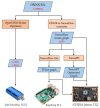Smart Tactile Sensing Systems Based on Embedded CNN Implementations
- PMID: 31963622
- PMCID: PMC7019580
- DOI: 10.3390/mi11010103
Smart Tactile Sensing Systems Based on Embedded CNN Implementations
Abstract
Embedding machine learning methods into the data decoding units may enable the extraction of complex information making the tactile sensing systems intelligent. This paper presents and compares the implementations of a convolutional neural network model for tactile data decoding on various hardware platforms. Experimental results show comparable classification accuracy of 90.88% for Model 3, overcoming similar state-of-the-art solutions in terms of time inference. The proposed implementation achieves a time inference of 1.2 ms while consuming around 900 μ J. Such an embedded implementation of intelligent tactile data decoding algorithms enables tactile sensing systems in different application domains such as robotics and prosthetic devices.
Keywords: convolutional neural network; embedding intelligence; tactile sensing systems.
Conflict of interest statement
The authors declare no conflict of interest.
Figures








Similar articles
-
A Quantized CNN-Based Microfluidic Lensless-Sensing Mobile Blood-Acquisition and Analysis System.Sensors (Basel). 2019 Nov 21;19(23):5103. doi: 10.3390/s19235103. Sensors (Basel). 2019. PMID: 31766471 Free PMC article.
-
Research on FBG Tactile Sensing Shape Recognition Based on Convolutional Neural Network.Sensors (Basel). 2024 Jun 24;24(13):4087. doi: 10.3390/s24134087. Sensors (Basel). 2024. PMID: 39000866 Free PMC article.
-
Hardware Implementation for Triaxial Contact-Force Estimation from Stress Tactile Sensor Arrays: An Efficient Design Approach.Sensors (Basel). 2024 Dec 7;24(23):7829. doi: 10.3390/s24237829. Sensors (Basel). 2024. PMID: 39686367 Free PMC article.
-
A Review of Embedded Machine Learning Based on Hardware, Application, and Sensing Scheme.Sensors (Basel). 2023 Feb 14;23(4):2131. doi: 10.3390/s23042131. Sensors (Basel). 2023. PMID: 36850729 Free PMC article. Review.
-
DeepFHR: intelligent prediction of fetal Acidemia using fetal heart rate signals based on convolutional neural network.BMC Med Inform Decis Mak. 2019 Dec 30;19(1):286. doi: 10.1186/s12911-019-1007-5. BMC Med Inform Decis Mak. 2019. PMID: 31888592 Free PMC article. Review.
Cited by
-
Nonlinear Hyperparameter Optimization of a Neural Network in Image Processing for Micromachines.Micromachines (Basel). 2021 Nov 30;12(12):1504. doi: 10.3390/mi12121504. Micromachines (Basel). 2021. PMID: 34945353 Free PMC article.
-
Machine Learning on Mainstream Microcontrollers.Sensors (Basel). 2020 May 5;20(9):2638. doi: 10.3390/s20092638. Sensors (Basel). 2020. PMID: 32380766 Free PMC article.
-
HedgeRank: Heterogeneity-Aware, Energy-Efficient Partitioning of Personalized PageRank at the Edge.Micromachines (Basel). 2023 Aug 31;14(9):1714. doi: 10.3390/mi14091714. Micromachines (Basel). 2023. PMID: 37763876 Free PMC article.
-
Comparative analysis of sandstone microtomographic image segmentation using advanced convolutional neural networks with pixelwise and physical accuracy evaluation.Sci Rep. 2025 Jul 1;15(1):22164. doi: 10.1038/s41598-025-07211-2. Sci Rep. 2025. PMID: 40596588 Free PMC article.
-
Editorial of Special Issue "Tactile Sensing Technology and Systems".Micromachines (Basel). 2020 May 16;11(5):506. doi: 10.3390/mi11050506. Micromachines (Basel). 2020. PMID: 32429431 Free PMC article.
References
-
- Ibrahim A., Pinna L., Seminara L., Valle M. Material-Integrated Intelligent Systems-Technology and Applications. John Wiley & Sons, Ltd.; WeinHeim, Germany: Dec 1, 2017. Achievements and Open Issues Toward Embedding Tactile Sensing and Interpretation into Electronic Skin Systems; pp. 571–594. Chapter 23. - DOI
-
- Alameh M., Ibrahim A., Valle M., Moser G. DCNN for Tactile Sensory Data Classification based on Transfer Learning; Proceedings of the 2019 15th Conference on Ph.D Research in Microelectronics and Electronics (PRIME); Lausanne, Switzerland. 15–18 July 2019; pp. 237–240. - DOI
-
- Luo S., Bimbo J., Dahiya R., Liu H. Robotic tactile perception of object properties: A review. Mechatronics. 2017;48:54–67. doi: 10.1016/j.mechatronics.2017.11.002. - DOI
-
- Gandarias J.M., Garcia-Cerezo A.J., Gomez-de Gabriel J.M. CNN-Based Methods for Object Recognition With High-Resolution Tactile Sensors. IEEE Sens. J. 2019;19:6872–6882. doi: 10.1109/JSEN.2019.2912968. - DOI
Grants and funding
LinkOut - more resources
Full Text Sources
Research Materials

